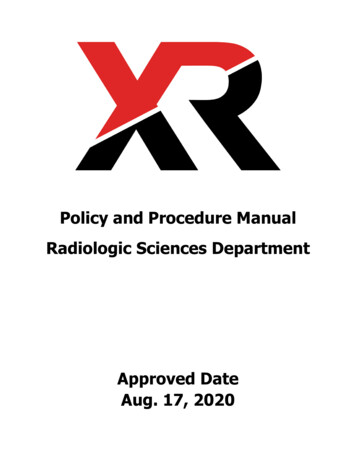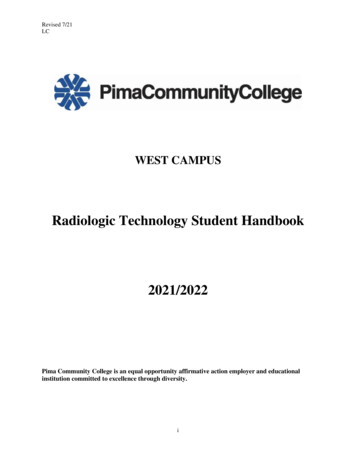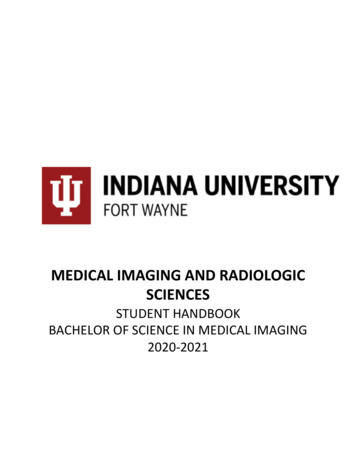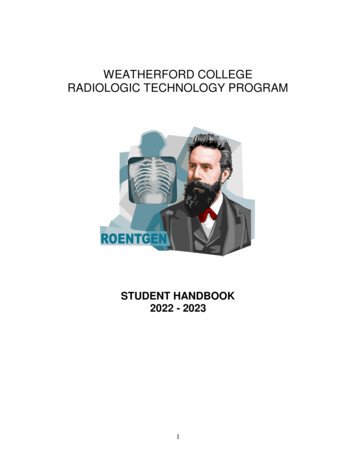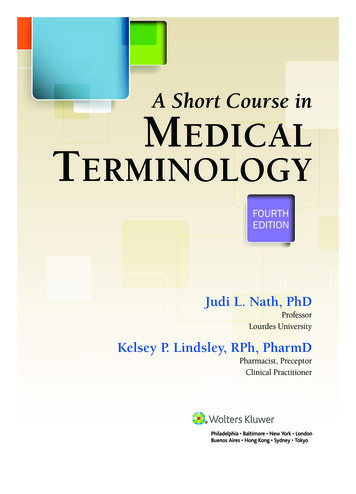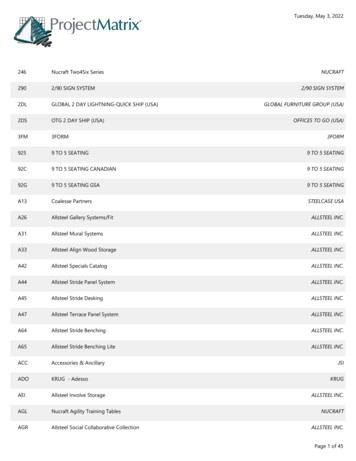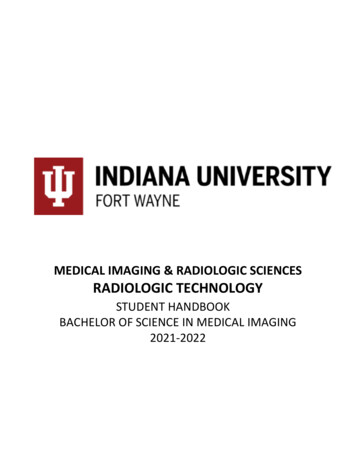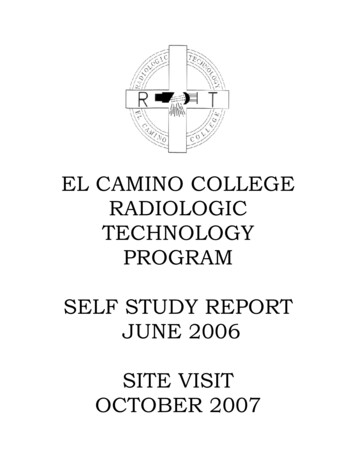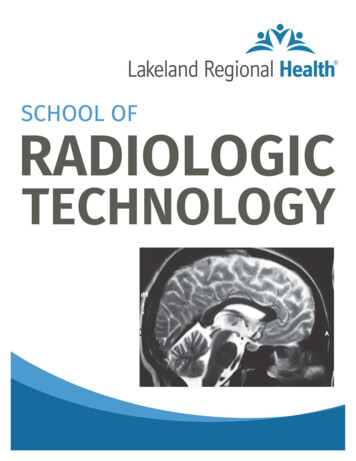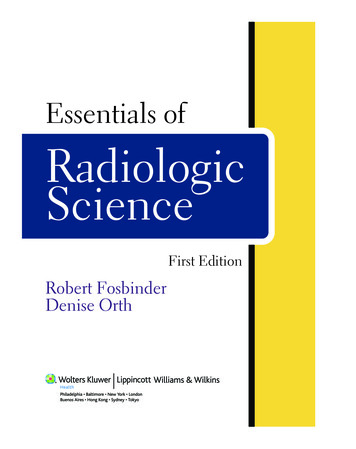
Transcription
Essentials ofRadiologicScienceFirst EditionRobert FosbinderDenise OrthFosbinder Text FM.indd iii9/21/2010 1:25:59 PM
Acquisitions Editor: Pete SabatiniProduct Director: Eric BrangerProduct Manager: Amy MillholenMarketing Manager: Allison PowellArtist: Jonathan DimesCompositor: Spi TechnologiesPrinter: C&C offsetCopyright 2011 Wolters Kluwer Health Lippincott Williams & Wilkins351 West Camden StreetBaltimore, Maryland 21201Two Commerce Square, 2001Market StreetPhiladelphia, PA 19103Printed in the United States of AmericaAll rights reserved. This book is protected by copyright. No part of this book may be reproducedin any form or by any means, including photocopying, or utilized by any information storage andretrieval system without written permission from the copyright owner.The publisher is not responsible (as a matter of product liability, negligence or otherwise) for anyinjury resulting from any material contained herein. This publication contains information relating to general principles of medical care which should not be construed as specific instructions forindividual patients. Manufacturers’ product information and package inserts should be reviewed forcurrent information, including contraindications, dosages and precautions.Library of Congress Cataloging-in-Publication DataFosbinder, Robert.Essentials of radiologic science / Robert Fosbinder, Denise Orth.p. ; cm.Includes index.Summary: “LWW is proud to introduce Essentials of Radiologic Science, a core, comprehensive textbook for radiologic technology students. Focusing on covering the crucial components andminimizing extraneous content, this text will help prepare students for success on the The AmericanRegistry of Radiologic Technologists Examination in Radiography and beyond into practice. Topicscovered include radiation protection, equipment operation and quality control, image production andevaluation, and patient care. This is a key and crucial resource for radiologic technology programs,focusing on providing relevancy and offering tools and resource to students of multiple learning types.These include a full suite of ancillary products, a variety of pedagogical features imbedded in the text,and a strong focus on the practical application of the concepts presented”—Provided by publisher.ISBN 978-0-7817-7554-01. Radiography, Medical—Textbooks. 2. Radiologic technologists—Textbooks. I. Orth, Denise.II. Title.[DNLM: 1. Technology, Radiologic. 2. Radiation Protection. WN 160]RC78.F575 2010616.07'572—dc222010030972The publishers have made every effort to trace the copyright holders for borrowed material. If theyhave inadvertently overlooked any, they will be pleased to make the necessary arrangements at the firstopportunity.To purchase additional copies of this book, call our customer service department at (800) 638-3030or fax orders to (301) 824-7390. International customers should call (301) 714-2324.Visit Lippincott Williams & Wilkins on the Internet: http://www.LWW.com. LippincottWilliams & Wilkins customer service representatives are available from 8:30 am to 6:00 pm, EST.111 2 3 4 5 6 7 8 9 10Fosbinder Text FM.indd iv9/21/2010 1:26:00 PM
PrefaceEssentials of Radiologic Science has been designed withstudents and educators in mind. The textbook is designed todistill the information in each of the content-specific areasdown to the essentials and to present them to the studentin an easy-to-understand format. We have always believedthat the difference between professional radiographers and“button pushers” is that the former understand the scienceand technology of radiographic imaging. To produce quality images, a student must develop an understanding ofthe theories and concepts related to the various aspects ofusing radiation. They should not rely on preprogrammedequipment and blindly set technical factors, as this is thepractice of “button pushers.” We have made a special effortto design a text that will help the students achieve technical competence and build their professional demeanor.We have placed the chapters in an order to help the student and educator progress from one topic to another. Thechapters can be used in consecutive order to build comprehension; however, each chapter can stand alone and canbe used in the order that is appropriate for any program.From the discovery of x-rays by Wilhelm Roentgento modern day, there have been major changes in howradiography is performed and the responsibilities of theradiographer. The advancement of digital imaging andthe elimination of film in a majority of imaging departments in the country have changed the required knowledge base for radiographers, which is different today thanjust a few years ago. This text addresses those changes andthe way radiography students must be educated.Our goal is to make this text a valuable resource forradiography students during their program of study andin the future. To this end, the text covers four of the fivecontent-specific areas contained in the registry examination: Physics, Radiographic Image Production, RadiationProtection, and Patient Care. The sections are independent and designed to be combined in whatever fitsthe instructor’s current syllabus. We believe the area ofPatient Positioning and Procedures is so extensive andcomplex that it requires a separate text.It is our hope that this text will exceed the expectationsof students and educators in their use of this book. Wehope that instructors find this book easy for their studentsto read and understand, and we know they will find it auseful addition to their courses.FeaturesThe text has many features that are beneficial to studentsas they learn about the fascinating world of radiography.Key terms are highlighted with bold text and are located atthe beginning of each chapter as well as inside the chaptermaterial. A glossary provides definitions for each key term.Features include objectives, key terms, full-color design,in-text case studies with critical thinking questions, criticalthinking boxes with clinical/practical application questionsand examples, video and animation callouts, chapter summaries, and chapter review questions. One of the most exciting features of this text is the use of over 250 illustrations,radiographic images, photographs, and charts that providegraphic demonstration of the concepts of radiologic sciencewhile making the text visually appealing and interesting.AncillariesThe text has ancillary resources available to the studentsto further assist their comprehension of the material.Student ancillaries include full text online, a registryvFosbinder Text FM.indd v9/21/2010 1:26:00 PM
viPrefaceexam–style question bank, a chapter review questionbank, videos, and animations. These animations complement the text with action-packed visual stimuli to explaincomplex physics concepts. For example, the topic of x-rayinteractions contains an animation demonstrating thex-ray photon entering the patient and then undergoingphotoelectric absorption, Compton scattering, or throughtransmission. Thus, the student can see how the exit radiation is made up of a combination of through transmittedand scattered photons. Videos provide the student withthe “real world” example of different scenarios including venipuncture, taking vital signs, using correct bodymechanics, hand hygiene, and patient rights.We have also included valuable resources for educators to use in the classroom. Instructor resources includePowerPoint slides, lesson plans, image bank, test generator, answer key for text review questions, and Workbookanswer key. Their purpose is to provide instructors withdetailed lecture notes that tie together the textbook andall the other resources we are offering with it.Fosbinder Text FM.indd viWorkbookAn Essentials of Radiologic Science Workbook isavailable separately to supplement the text and to helpthe students apply knowledge they are learning. TheWorkbook provides additional practice and preparationfor the ARRT exam and includes registry-style reviewquestions, as well as other exercises (crossword puzzles,image labeling) and a laboratory experiments section. Allthe questions in the Workbook are correlated directly withthe text. Use of the Workbook will enhance learning andthe enjoyment of radiologic science concepts.Robert FosbinderDenise Orth9/21/2010 1:26:02 PM
Fosbinder Text FM.indd vii9/21/2010 1:26:02 PM
Fosbinder Text FM.indd viii9/21/2010 1:26:10 PM
Fosbinder Text FM.indd ix9/21/2010 1:26:19 PM
xUser’s GuideAdditional Learning ResourcesValuable ancillary resources for both students and instructors are available onthePoint companion website at http://thepoint.lww.com/FosbinderText. See theinside front cover for details on how to access these resources.Student Resources include a registry exam-style question bank, a chapter reviewquestion bank, videos, and animations.Instructor Resources include PowerPoint slides, lesson plans, image bank, testgenerator, answer key for text Review Questions, and answer key for Workbookquestions.Fosbinder Text FM.indd x9/21/2010 1:26:31 PM
ReviewersJohn H. Clouse, MSR, RTDeputy DirectorCenter for Disaster Medicine PreparednessDepartment of Emergency MedicineUniversity of Louisville School of MedicineLouisville, KentuckyAnthony E. Gendill, BA, BS, DCMedical Instructor/Award Winning Faculty MemberAllied Health DepartmentInstitute of Business and Medical CareersFort Collins, ColoradoKelli Haynes, MSRS, RT (R)Director of Undergraduate Studies/Associate Professor/Graduate FacultyRadiologic SciencesNorthwestern State UniversityShreveport, LouisianaJudy Lewis, MEdProgram Director/InstructorRadiologic TechnologyMississippi Gulf Coast Community CollegeGautier, MississippiCatherine E. Nobles, RT (R), MEdDidactic/Clinical InstructorRadiography ProgramHouston Community College SystemHouston, TexasGeorge Pales, PhD, RT (R) (MR) (T)Radiography Program DirectorHealth Physics and Clinical SciencesUniversity of Nevada, Las VegasLas Vegas, NevadaLisa F. Schmidt, PhD, RT (R) (M)Program DirectorRadiographyPima Medical InstituteChula Vista, CaliforniaDeena Slockett, MBAProgram Coordinator/Associate ProfessorRadiologic SciencesFlorida Hospital College of Health SciencesOrlando, FloridaxiFosbinder Text FM.indd xi9/21/2010 1:26:33 PM
AcknowledgmentsI would like to thank all of my former students for theirhelp in reading the book. I would also like to thank myfamily: my mother Kay; my sisters, Carol and Linda; mybrother, Tom; and my wife, Tracy, for all of her help intyping.Robert FosbinderQ1We would like to acknowledge those individuals whohave helped develop and publish this text. First, thankyou, Peter Sabatini and Amy Millholen, for providing theassistance, encouragement, and support needed to complete this text. Thanks also to the production staff whosededicated work and professionalism are evident in thequality of their work. Special thanks to Jonathan Dimesfor his wonderful illustrations and vision. We wouldalso like to extend our appreciation to Starla Mason fordeveloping the workbook and ancillary resources. Manythanks to my colleagues for their encouragement andsupport.Finally, to my husband Mark and our family, I wishto express my true appreciation for your unwavering support, encouragement, and understanding during the process of writing this text.Denise OrthxiiFosbinder Text FM.indd xii9/21/2010 1:26:33 PM
ContentsPrefacevUser’s GuideReviewersviixiAcknowledgementsxiiPART I: BASIC PHYSICSChapter 1Radiation Units, Atoms, and Atomic Structure2Chapter 2Electromagnetic Radiation, Magnetism, and ElectrostaticsChapter 3Electric Currents and Electricity1430PART II: CIRCUITS AND X-RAYPRODUCTIONChapter 4Transformers, Circuits, and Automatic Exposure Control (AEC)Chapter 5X-Ray TubesChapter 6X-Ray Production72Chapter 7X-Ray Interactions814560PART III: IMAGE FORMATIONChapter 8Intensifying Screens92xiiiFosbinder Text FM.indd xiii9/21/2010 1:26:33 PM
xivContentsChapter 9Film and Processing102Chapter 10Density and ContrastChapter 11Image FormationChapter 12Grids and Scatter Reduction122139164PART IV: SPECIAL IMAGING TECHNIQUESChapter 13Fluoroscopy, Conventional and DigitalChapter 14Digital Imaging204Chapter 15Quality Control221Chapter 16Mammography240Chapter 17Computed TomographyChapter 18Magnetic Resonance Imaging184253271PART V: RADIATION PROTECTIONChapter 19Radiation Biology286Chapter 20Radiation Protection and RegulationsChapter 21Minimizing Patient Exposure and Personnel Exposure308320PART VI: PATIENT CAREChapter 22Medical and Professional EthicsChapter 23Patient Care, Medications, Vital Signs, and Body MechanicsGlossary335346361Index 367Fosbinder Text FM.indd xiv9/21/2010 1:26:34 PM
2Electromagnetic Radiation,Magnetism, and ElectrostaticsObjectivesKey TermsUpon completion of this chapter, the studentwill be able to: amplitude (of awave) intensity bipolar magnetic dipole1. Name the different types of electromagneticradiation and describe each.2. Describe the characteristics of electromagneticwaves.3. Describe the relationships betweenfrequency, wavelength, velocity, and energy ofelectromagnetic radiation.4. Define radiation intensity and describe how itvaries with distance from the radiation source.5. State the laws and units of magnetism.6. Identify the different types of magneticmaterials. coulomb Coulomb’s law diamagneticmaterials electric field inverse square law magnetic domain magnetic field magnetic induction magnetism electrification nonmagneticmaterials electromagneticspectrum paramagneticmaterials electrostatics period (of a wave) ferromagneticmaterials7. Describe the methods of electrification. frequency (of awave)8. State the laws of electrostatics. gauss (G) photon spin magneticmoment tesla (T) wavelength9. State Coulomb’s law.14Fosbinder Text Chap02.indd 149/20/2010 6:32:10 PM
Chapter 2: Electromagnetic Radiation, Magnetism, and ElectrostaticsIntroductionAll radiologic equipment is based on thelaws of electricity and magnetism. Thus, anunderstanding of the underlying principles ofelectricity and magnetism aids in understanding radiologic equipment and image production. In this chapter, we review the types andcharacteristics of electromagnetic radiationand discuss properties of magnetism, includingtypes of magnetic materials, magnetic fields,and the laws and units of magnetism. Magneticresonance imaging (MRI) has developed intoa diagnostic imaging tool for imaging the body.In radiography, the properties of magnetism areused to make the anode rotate in the x-ray tube.Finally, we consider the laws of electrostaticsand the study of stationary electric charges.A thorough understanding of the principles ofstationary charges will assist the student in understanding how electricity is used in the x-ray tube.ElectromagneticRadiationAn animation for this topic can be viewedat http://thepoint.lww.com/FosbinderTextTypes of Electromagnetic RadiationAll electromagnetic radiation consists of simultaneouselectric and magnetic waves. Typically, only one of thesewaves is used in illustrations. These waves are really fluctuations caused by vibrating electrons within the fields.The amount of vibrations of the electrons will determinethe frequency and wavelength for the various types ofelectromagnetic radiations. Electromagnetic radiationtravels at the speed of light, and each type has its ownunique frequency and wavelength (Fig. 2.1).Electromagnetic radiation may appear in the form ofvisible light, x-rays, infrared, or radio waves, depending onFosbinder Text Chap02.indd 15Electric field15Magnetic fieldFigure 2.1. Electromagnetic waveform illustrates the electricand magnetic waves which make up the electromagnetic waveform. Typically, only the electric wave is shown in illustrations.its energy. The entire band of electromagnetic energies isknown as the electromagnetic spectrum.The electromagnetic spectrum lists the differenttypes of electromagnetic radiations varying in energy,frequency, and wavelengths. The energy of the radiationis measured in electron volts or eV. Figure 2.2 illustratesthe different forms of the electromagnetic spectrumfrom long-wavelength, low-energy radio waves, to shortwavelength, high-energy gamma rays. Although Figure2.2 appears to indicate sharp transitions between the typesof radiations, there are no clear boundaries between thevarious regions in the electromagnetic spectrum.Radio WavesRadio waves are long-wavelength (1–10,000 m), lowenergy radiation waves. A radio wave that is 10,000 m inlength is equivalent to placing approximately 92 footballfields end-to-end. Radio frequency radiation is used inMRI. Cell phones utilize radio waves to transmit information from one cell tower to another and finally to acell phone. Television antennae receive the electromagnetic wave from the broadcast station and the image isdisplayed on the television screen. Music can be heardbecause it reaches our ears in the form of a radio wave.Radar and MicrowavesRadar and microwaves have shorter wavelengths (10 1–10 4m) and higher energy than radio waves. Microwavesare used in ovens, in transportation, and by law enforcement officers to monitor the speed of cars. In a microwaveoven, the microwave energy forces the water moleculesin food to rapidly vibrate, thus heating the food.Infrared RadiationInfrared radiation, or heat, has shorter wavelengths andhigher energy than radar and microwaves (10 1–10 4 m).9/20/2010 6:32:10 PM
16Part I: Basic 0-910-1010-11Wavelength (in meters)LongShortBacteriaProteinThis dotBaseballFootball fieldWatermoleculeCellSize of a enFMRadio107Light equency (waves per h101102103104Energy of one photon (electron volts)105106HighFigure 2.2. Electromagnetic spectrum illustrates the range of electromagnetic radiation.Infrared radiation can heat nearby objects. For example,you can feel the heat from your toaster, which uses infrared radiation. The high-energy end of the infrared regionis visible and can be seen in the red heating elements ofyour toaster.Visible LightVisible light selectively activates cells in the eye. It occupies a narrow band in the electromagnetic spectrum,with wavelengths between 10 6 and 10 7 m. The colorred has the longest wavelength and lowest energy. Blueand violet colors have the highest energy and the shortestwavelengths in the visible spectrum.UltravioletUltraviolet is the part of the spectrum just beyond thehigher energy end of the visible light region. Ultravioletwavelengths range from 10 7 to 10 9 m. Ultraviolet lightsare used in biological laboratories to destroy airborneFosbinder Text Chap02.indd 16bacteria, and they are believed to be responsible for themajority of sunburn and skin cancer.X-Rays and Gamma RaysX-rays and gamma rays have wavelengths between 10 9and 10 16 m. They are very short wavelength, highfrequency, high-energy radiation. The energy is measuredin thousands of electron volts (keV) and is capable ofionization. Ionizing radiation such as x-rays and gammarays has enough energy to remove an electron from itsorbital shell.The only difference between x-rays and gamma rays istheir origin. X-rays in radiology come from interactionswith electron orbits. Gamma rays come from nucleartransformations (decay) and are released from thenucleus of a radioactive atom. Some x-rays in radiologyhave higher energy than some gamma rays and are usedin radiation therapy to treat cancer. X-radiation is utilizedin various industries including for screening baggage in9/20/2010 6:32:12 PM
Chapter 2: Electromagnetic Radiation, Magnetism, and Electrostaticsairport security and large crates of merchandise at ports ofentry as well as for imaging chest plates the military willuse in combat.1 cycleCharacteristics of ElectromagneticRadiationElectromagnetic radiation consists of vibrations inelectric and magnetic fields. It has no charge and nomass and travels at the speed of light. The waves movein a sinusoidal (sine) waveform in electric and magneticfields. Electromagnetic radiation is described in terms ofthe following characteristics: Velocity: how fast the radiation moves Frequency: how many cycles per second are in thewave Period: the time for one complete cycle Wavelength: the distance between correspondingparts of the wave Amplitude: the magnitude of the wave Energy: the amount of energy in the wave Intensity: the flux of energyVelocityAll electromagnetic radiation travels in a vacuum or inair at 3 108 m/s (186,000 miles/s), regardless of whetherit is in a wave or particle form. Even though this is incredibly fast, light requires some time to travel huge distances.For example, it takes 8 minutes for light from the Sun toreach the Earth.FrequencyThe frequency of a wave is the number of cycles persecond. That is, the frequency is the number of peaks orvalleys occurring each second. The unit of frequency ishertz (Hz), which is one cycle per second. In the UnitedStates, electricity has a frequency of 60 Hz, that is, 60cycles per second. A typical radio wave has 700,000 Hz(700 kHz). A 1,000 Hz is equal to 1 kHz. One megahertz(MHz) is equal to one million (106) Hz or cycles persecond.PeriodThe period of a wave is the time required for onecomplete cycle. A wave with a frequency of two cyclesFosbinder Text Chap02.indd 1717Time (s)Frequency 2 cycles/sPeriod 0.5 sFigure 2.3. The relationship between frequency and periodof a waveform.per second has a period of one-half second; that is, onecomplete wave cycle occurs each half second. Figure 2.3illustrates the relationship between frequency and period(time) in a sine wave.WavelengthThe distance between adjacent peaks or adjacent valleys of a wave is the wavelength and is represented bylambda (l). Wavelength is one of the important characteristics in determining the properties of x-rays. Electromagnetic radiation with shorter wavelengths hashigher energy and frequencies and greater penetration.Wavelength is measured in meters, centimeters, ormillimeters. Figure 2.4 illustrates the relation betweenwavelength and frequency.Electromagnetic wave velocity, frequency, and wavelength are related and a change in one factor causes achange in one or both of the other factors. The wave isdemonstrated with this formula:c flwhere c (velocity) is the speed of light (3 108 m/s, inair), f is the frequency, and lambda (l) is the wavelength.Note that the product of frequency and wavelength mustalways equal the velocity. Thus, frequency and wavelength are inversely proportional. Therefore, if the frequency increases, the wavelength must decrease, and ifthe frequency decreases, the wavelength must increase.For example, if frequency is doubled, the wavelength ishalved, and if the frequency is tripled, the wavelength isreduced by one third.9/20/2010 6:32:13 PM
18Part I: Basic Physics1 wavelengthShort wavelengthHigh frequencyDistance fromwave sourceA1 cycle1 wavelengthDistance fromwave sourceLong wavelengthLow frequencyB1 cycle 1 hertzFigure 2.4. A: Demonstrates the relationship between frequency and wavelength. When a short wavelength is seen, there is agreater number of vibrations. Note how the peaks are closer together. This waveform has high penetrability and represents anx-ray waveform. B: In the bottom waveform, note the distance between the peaks. As the distance between the peaks increases,the wavelength becomes longer and there are fewer peaks. This waveform has low penetrability.CRITICAL THINKINGCRITICAL THINKINGA radio station is broadcasting a signal with afrequency of 27,000 kHz. What is the wavelength ofthe signal in meters?What is the frequency in MHz of a cell phone signalif the wavelength is 333 mm 3 108 m/s?Answerc 3 108 m/ sf 27,000 kHz3 108 m/ sl 27,000 kHz3 108 m/ sl 2.7 104l 11.1mFosbinder Text Chap02.indd 18Answerl 333mm3 108 m/ sf 333mm3 108 m1f 333 10 -3 m s3 108 mf 333 10 -3 mf 0.009 105 Hz or 900MHz9/20/2010 6:32:14 PM
19Chapter 2: Electromagnetic Radiation, Magnetism, and Electrostatics1 cycleAmplitudeDistance fromwave sourceAmplitudeA1 cycleAmplitudeDistance fromwave sourceAmplitudeBFigure 2.5. A: A bowling ball is dropped into a tank of smooth water. The weight of the object causes the water to havelarge ripples with lots of energy. B: This wave represents the effect if a baseball were dropped into smooth water, and theripples are smaller and therefore have less energy.AmplitudeThe amplitude of a wave is the maximum height of thepeaks or valleys (in either direction) from zero. As theenergy of the wave increases, the height of the wave alsoincreases. Figure 2.5 compares the amplitudes of twoelectromagnetic waves as a function of time.Energy: Electromagnetic Radiation as a ParticleElectromagnetic radiation usually acts as a wave, butsometimes it acts as a particle. When electromagneticradiation acts as a wave, it has a definite frequency,period, and wavelength. When electromagnetic radiationacts as a particle, it is called a photon or quanta. We usethe photons or bundles of energy to produce x-radiation.The energy and frequency of the photons are directlyproportional, but wavelength and energy are inverselyproportional. Thus, the higher the energy, the shorter thewavelength and the higher the frequency. The formulathat describes the relationship between photon energyand frequency is expressed asE hfwhere E is photon energy in electron volts, h is a conversionfactor called Planck’s constant (4.15 10 15 eVs), and f isthe photon frequency.Fosbinder Text Chap02.indd 19CRITICAL THINKINGWhat is the frequency of a 56-keV x-ray photon?AnswerE h fEf h56 keVf 4.15 10 -15 eVs56 104 eVf 4.15 10 -15 eVsf 1.34 1019 HzCRITICAL THINKINGHow much energy is found in one photon of radiation during a cell phone transmission of 900 kHz?AnswerE h fE (4.15 10 -15 e V s)(9 105 s)E 3.7 10 -9 eV9/20/2010 6:32:16 PM
20Part I: Basic PhysicsRadiation Intensity and the Inverse Square LawAll electromagnetic radiation travels at the speed of lightand diverges from the source at which it is emitted. Intensity is energy flow per second and is measured in watts/cm2. The intensity of the radiation decreases with anincrease in the distance from the source. This is becausethe x-ray energy is spread over a larger area. This relationis known as the inverse square law. It is called the inversesquare law because the intensity is inversely proportionalto the square of the distance. Figure 2.6 illustrates howthe intensity decreases as the distance from the sourceincreases.Mathematically, the inverse square law is expressed asfollows:where I1, old intensity; I2, new intensity; d12, old distancesquared; d22, new distance squared. If the distance fromthe x-ray source is doubled, the intensity decreases by afactor of 4. That is, the intensity at twice the distance isone-fourth the original value. If the distance from thex-ray source is halved, the intensity is four times greater.The exposure and exposure rate from an x-ray source alsofollow the inverse square law. To decrease radiation exposure during a fluoroscopic exam, a technologist needs toincrease his or her distance from the x-ray tube. Every stepaway from the tube decreases the amount of radiation thetechnologist will be exposed to.2æd öI d2I2 I1 ç 1 or I2 1 1d2è d2 øCRITICAL THINKINGWhat is the exposure rate 4 m from a source that hasan exposure rate of 32 mR/h at a distance of 1 m fromthe source?Radiation sourceAnswerIf I1 is the exposure rate at 1 m and I2 is the exposurerate at 4 m, thenæd öI2 I1 ç 1 è d2 ø22æ1öI2 I1 ç è4øæ 1ö 32 ç è 16 ø 2mR/ hDistance 1CRITICAL THINKINGThe x-ray intensity is measured at 40 mR/h at 36 in.What is the intensity at 72 in?AnswerDistance 2Figure 2.6. The inverse square law relates the radiation intensity to the distance from the source. As distance is increased,the intensity of the radiation is decreased by one fourth.Fosbinder Text Chap02.indd 20I1 d12d2236 1,296722 5,184[40 1,296] 10mR/ h5,184I2 9/20/2010 6:32:18 PM
Chapter 2: Electromagnetic Radiation, Magnetism, and Electrostatics21MagnetismNonmagnetizedEarly man discovered that some rocks seemed to havemagical powers. They were called lodestones. Lodestonesare natural magnets and attract pieces of iron. Magnetism is the ability of a lodestone or magnetic material toattract iron, nickel, and cobalt. This magnetic property isused in medical imaging.Types of Magnetic MaterialsDifferent types of materials respond differently tomagnetic fields. There are four types of magneticmaterials:1. ferromagnetic materials, which react strongly withmagnets or in a magnetic field2. paramagnetic materials, which are weakly attractedto magnets3. diamagnetic materials, which are weakly repelledby all magnetic fields4. nonmagnetic materials, which do not react in amagnetic fieldEach of these is discussed in detail below.Ferromagnetic MaterialsFerromagnetic materials are attracted to a magnet. Ferromagnetic materials—including iron, cobalt, and nickel—are made up of small groups of atoms called magneticdomains. These domains act like tiny magnets insidethe material. In the nonmagnetized state the domainsare randomly oriented, so there is no net magnetization.When a ferromagnetic material is placed in a magneticfield the domains are aligned. After the magnetic fieldis removed, the domains remain aligned forming a permanent magnet. Alnico is an alloy made of aluminum,nickel, and cobalt. It contains the magnetic properties ofeach metal to form a strong magnet. Figure 2.7 illustrateshow ferromagnetic materials are magnetized by aligning the domains inside the material. Heating a magnetcan destroy its magnetism because hea
Student ancillaries include full text online, a registry Essentials of Radiologic Science has been designed with students and educators in mind. The textbook is designed to distill the information in each of the content-specifi c areas down to the essentials and to present them to the student in an easy-to-understand format. We have always believed
